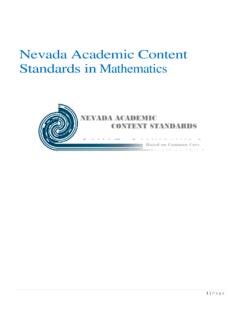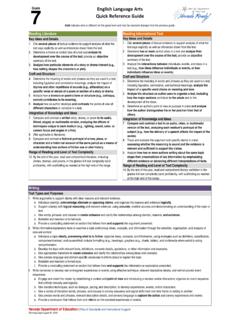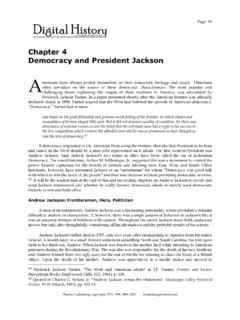Transcription of Andrew Jackson’s Speech to Congress on ‘Indian Removal’
1 Working Copy: September 10, 2016 Andrew jackson s Speech to Congress on Indian Removal by Andrew jackson Difficulty: Easy Moderate Challenging Text Type: Informational Literary Text Complexity: Quantitative: 1390L Qualitative: Text structure and the use of language make this a more challenging piece of text. The purpose of the text requires the reader to make inferences about relationships that will require some content specific background knowledge. Writing Type: Argumentative Informational/Explanatory About this Lesson Do NOT read this to students. Andrew jackson , in a 1830 Speech to Congress , discusses the benefits of moving Native Americans onto reservations. Materials: Copies of student text ( ) Copies of the TPRC (Think, Predict, Read, Connect) graphic organizer (see compendium page 20) Copies of the Vocabulary Knowledge Rating Scale graphic organizer (see compendium page 36) Copies of the It Says, I Say, and So graphic organizer (see compendium page 60) Copies of the text dependent questions (see pages 7- 9 in this document) Copies of Exit Slips (see compendium page 82) Copies of Somebody-Wanted-But-So-Then graphic organizer (see compendium page 90) Copies Elaboration Techniques handout (see compendium pages 112-113) Copies of the Argumentative Writing Checklist (see compendium page 115) 1 Andrew jackson s Speech to Congress on Indian Removal Phase 1: Key Ideas and Details Orient Step 1: Motivate ( Modeled, Shared, Collaborative, Independent) Explain that students will read a Speech given by Andrew jackson about the relocation of Native Americans.
2 Distribute the TPRC (Think, Predict, Read, Connect) graphic organizer (see compendium page 20) and follow the TPRC procedures on compendium page 19. Ask students to write down their predictions about what they will read on the TPRC graphic organizer. Remind students to keep this graphic organizer for use when they read the Speech . Step 2: Introduce Big Task ( Modeled, Shared, Collaborative, Independent) Read the Big Task (see page 7 in this document). Is the Indian Removal Act of 1830 government sponsored racism? Use Andrew jackson s own words to support your argument. Annotate the Big Task. Step 3: Introduce TDQs ( Modeled, Shared, Collaborative, Independent) (See Step 6 below and TDQs 1-6 on page 7 .) Step 4: Address Vocabulary ( Modeled, Shared, Collaborative, Independent) Pre-teach vocabulary (see Knowledge Rating Scale strategy on compendium page 35). Word/Phrase After Paragraph or Line Student Friendly Explanation benevolent paragraph 1 well-meaning consummation paragraph 1 completion provision paragraph 1 a provided thing pecuniary paragraph 2 relating to money red man paragraph 4 an archaic term, now considered offensive, for Native Americans annihilation paragraph 5 destruction Step 5: Preview/Provide Context ( Modeled, Shared, Collaborative, Independent) Read the purpose setting statement: Andrew jackson (1767-1845) was the seventh president of the United States.
3 In this Speech he discusses the Indian Removal Act, which relocated native tribes to what is now Oklahoma. As you read the Speech , take notes on the way that jackson uses rhetoric to justify his actions. 2 Andrew jackson s Speech to Congress on Indian Removal Engage Step 6: Read Sections and Answer TDQs ( Modeled, Shared, Collaborative, Independent) Have students number each paragraph. Ask students to draw a wavy line between paragraphs to show the sections to read. Pause to ask the TDQs below after each section. Use the It Says, I Say, and So strategy (see compendium page 59). After Paragraph or Line TDQ Standard(s) Paragraph 1 What is the subject of the Speech and what does the author have to say about it? Paragraph 2 What can the reader reasonably infer when the author states, ..to cast off their savage habits and become an interesting, civilized, and Christian community. ? Paragraph 2 What does jackson say is the benefit of relocating Native Americans ?
4 Cite sufficient evidence to support your inference Paragraph 2 What central idea is most fully developed in jackson s Speech ? Paragraph 2 Identify details that refine the central idea of the Speech . Paragraph 3 How does paragraph 3 of jackson s Speech contribute to his purpose? Reflect Step 7: Reflect ( Modeled, Shared, Collaborative, Independent) Use the Exit Slip strategy (see compendium page 81) and ask students to respond to this statement: Write one thing you learned from today s reading. Step 8: Practice Fluent Reading ( Modeled, Shared, Collaborative, Independent) Practice fluent reading by using the Read Aloud to Students strategy (see compendium page 75). Have student follow along in the text as you read the Speech . Ask students to mark on the text areas where you changed your rate of speed or inflection and be ready to explain why those changes occurred. 3 Andrew jackson s Speech to Congress on Indian Removal Phase 2: Craft and Structure Orient Step 1: Review Key Ideas and Details ( Modeled, Shared, Collaborative, Independent) Have students share their It Says, I Say, So answers to the TDQs.
5 Encourage them to ask, Why did you write that? and to steal relevant information. Step 2: Review Big Task ( Modeled, Shared, Collaborative, Independent) Review answers to TDQs from Phase 1 that might be useful in answering the Big Task. Step 3: Introduce TDQs ( Modeled, Shared, Collaborative, Independent) (See Step 5 below and TDQs 1-4 on page 8.) Step 4: Review Vocabulary ( Modeled, Shared, Collaborative, Independent) Review essential vocabulary using the Flashlight Vocabulary strategy (see compendium page 45). Engage Step 5: Read Sections and Answer TDQs ( Modeled, Shared, Collaborative, Independent) Ask students to draw [brackets] around paragraphs to show the sections to read. Pause to ask the TDQs below after each section. Have students continue to use the It Says, I Say, So What strategy (see compendium page 59) using the TDQs from Phase 2 as their guide. After Paragraph or Line TDQ Standard(s) Paragraph 1 What is the most likely reason President jackson used the word benevolent in paragraph 1?
6 Paragraph 2 and 3 What words and phrases does the speaker use to state ideas in a vivid way? Paragraph 3 How does paragraph 3 contribute to the development and refinement of the author s claim? End What is the author s viewpoint on Native American relocation? Is the author effective in advancing that viewpoint? Why or why not? Cite evidence from the Speech in your analysis. 4 Andrew jackson s Speech to Congress on Indian Removal Reflect Step 6: Reflect ( Modeled, Shared, Collaborative, Independent) With a partner, have students share their answers from their I Say, It Says, So What strategy and ask each other why and steal answers and rationales to include in their answers. Step 7: Practice Fluent Reading ( Modeled, Shared, Collaborative, Independent) Use the Paired Reading strategy (see compendium page 73). Have students read paragraph 3 aloud to a partner. Explain to students that you would like them to read this paragraph as if they are trying to persuade someone to agree with their thinking.
7 5 Andrew jackson s Speech to Congress on Indian Removal Phase 3: Integration of Knowledge and Ideas Orient St ep 1: Review Craft and Structure ( Modeled, Shared, Collaborative, Independent) Review the key ideas and details TDQs from Phase 1 and craft and structure TDQs from Phase 2. Use the responses to the Exit Slips from Phase 2 to generate small group discussions. Step 2: Review Big Task ( Modeled, Shared, Collaborative, Independent) Review It Says, I Say, So and answers to TDQs from Phase 2 that might be useful in answering the Big Task. Step 3: Introduce TDQs ( Modeled, Shared, Collaborative, Independent) (See Step 5 below and TDQs 1-2 on page 9.) Step 4: Step 4: Review Vocabulary ( Modeled, Shared, Collaborative, Independent) Review essential vocabulary using the Two In One strategy (see compendium page 47). Engage Step 5: Read Section and Answer TDQs ( Modeled, Shared, Collaborative, Independent) Ask students to draw [[double brackets]] around paragraphs to show the sections to read.
8 Pause to ask the TDQs below after each section. Use the It Says, I Say, So strategy (see compendium page 59) to gather additional information from the Speech as it relates to the phase 3 TDQs. After Paragraph or Line TDQ Standard(s) Paragraph 2 What argument is presented in the text? Paragraph 2 Assess the evidence presented in the Speech . Explain why the evidence is valid or invalid. Reflect Step 6: Reflect ( Modeled, Shared, Collaborative, Independent) Using the Somebody-Wanted-But-So-Then strategy (see compendium page 89)to assist them in capturing the events in the text such as conflict, resolution, and summarization. Step 7: Practice Fluent Reading ( Modeled, Shared, Collaborative, Independent) Practice fluent reading using the Paired Reading strategy (see compendium page 73) and have students read the first paragraph as if they were the president addressing Congress . 6 Andrew jackson s Speech to Congress on Indian Removal Phase 4: Argue or Inform/Explain Orient Step 1: Review Big Task ( Modeled, Shared, Collaborative, Independent) Review the type of writing and content expected in the Big Task.
9 Step 2: Review All Previous TDQs ( Modeled, Shared, Collaborative, Independent) Review It Say, I Say, So and answers to TDQs that may be helpful when answering the Big Task, validating or redirecting as necessary. Step 3: Introduce/Review the Writing Essentials ( Modeled, Shared, Collaborative, Independent) Introduce the Argumentative Writing Essentials (see compendium page 96). Engage Step 4: Prewrite ( Modeled, Shared, Collaborative, Independent) Fill out the Big Task Graphic Organizer (see page 10 in this document). Begin brainstorming reasons people follow the crowd. As students identify each reason, use the Elaboration Techniques handout (see compendium pages 112-113) to help students select an appropriate elaboration technique. Step 5: Draft ( Modeled, Shared, Collaborative, Independent) Using the Argumentative Writing Graphic Organizer (see compendium pages 98-103), ask students to begin drafting their essays. Remind students to use the Elaboration Techniques handout from Step 4 to select an appropriate way to elaborate for each Body Paragraph section on the graphic organizer.
10 After students have completed their Argumentative Writing Graphic Organizers, arrange the pages to logically organize their information. Have students write their final drafts. Step 6: Revise/Edit ( Modeled, Shared, Collaborative, Independent) Encourage students to proofread their final drafts using the Argumentative Writing Student Checklist (see compendium page 114). Reflect Step 7: Provide Individual Feedback Confer with individual students to discuss their paragraphs based on the Argumentative Rubric. Step 8: Provide Group Feedback Review overall strengths and weaknesses with class. Share effective elaboration from one or two students essays. Share ineffective elaboration from one or two students essays and brainstorm possible revisions. 7 Andrew jackson s Speech to Congress on Indian Removal Andrew jackson s Speech Big Task and TDQs Phase 1: What does the text say? THE BIG TASK Is the Indian Removal Act of 1830 government sponsored racism? Use Andrew jackson s own words to support your argument.



















